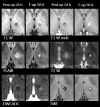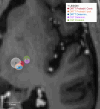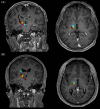Quantitative Tractography-Based Evaluations in Essential Tremor Patients after MRgFUS Thalamotomy
- PMID: 39367682
- PMCID: PMC11648004
- DOI: 10.1002/mdc3.14219
Quantitative Tractography-Based Evaluations in Essential Tremor Patients after MRgFUS Thalamotomy
Abstract
Background: Magnetic resonance-guided focused ultrasound (MRgFUS) targeting the thalamic ventral intermediate nucleus (VIM) is an innovative treatment for drug-refractory essential tremor (ET). The relationship between lesion characteristics, dentate-rubro-thalamic-tract (DRTT) involvement and clinical benefit remains unclear.
Objectives: To investigate whether clinical outcome is related to lesion volume and/or its overlap with the DRTT. To compare the reliability of probabilistic versus deterministic tractography in reconstructing the DRTT and improving VIM targeting.
Methods: Forty ET patients who underwent MRgFUS thalamotomy between 2019 and 2022 were retrospectively analyzed. Clinical outcomes and adverse effects were recorded at 1/6/12 months after the procedure. The DRTT was generated using deterministic and probabilistic tractography on preoperative diffusion-tensor 3 T-images and location and volume of the lesion were calculated.
Results: Probabilistic tractography identified both decussating (d-DRTT) and non-decussating (nd-DRTT) components of the DRTT, whereas the deterministic approach only identified one component overlapping with the nd-DRTT. Despite the lesions predominantly intersecting the medial portion of the d-DRTT, with a significantly greater overlap in responder patients, we observed only a non-significant correlation between tremor improvement and increased d-DRTT-lesion overlap (r = 0.22, P = 0.20). The lesion volume demonstrated a significant positive correlation with clinical improvement at 1-day MRI (r = 0.42, P < 0.01).
Conclusion: Variability in the reconstructed DRTT position relative to the lesion center of mass, even among good responders, suggests that this fiber bundle is unlikely to be considered the sole target for a successful MRgFUS thalamotomy in ET. Indirect individualized targeting allows for more precise and reproducible identification of actual treatment coordinates than the direct method.
Keywords: MR‐guided focused ultrasound; dentato‐rubro‐thalamic tract; essential tremor; thalamotomy; tractography.
© 2024 The Author(s). Movement Disorders Clinical Practice published by Wiley Periodicals LLC on behalf of International Parkinson and Movement Disorder Society.
Figures




References
MeSH terms
LinkOut - more resources
Full Text Sources
Miscellaneous

